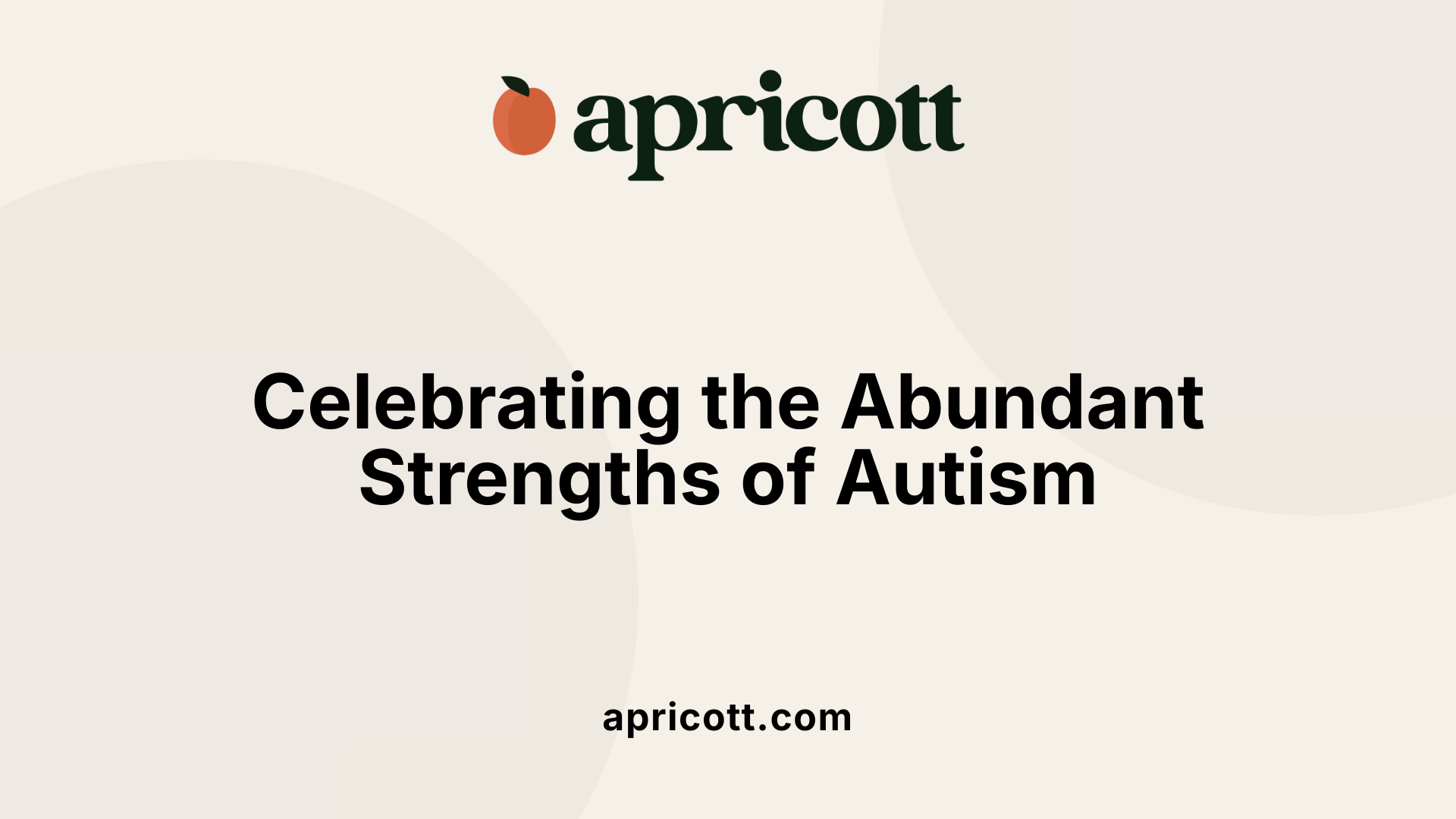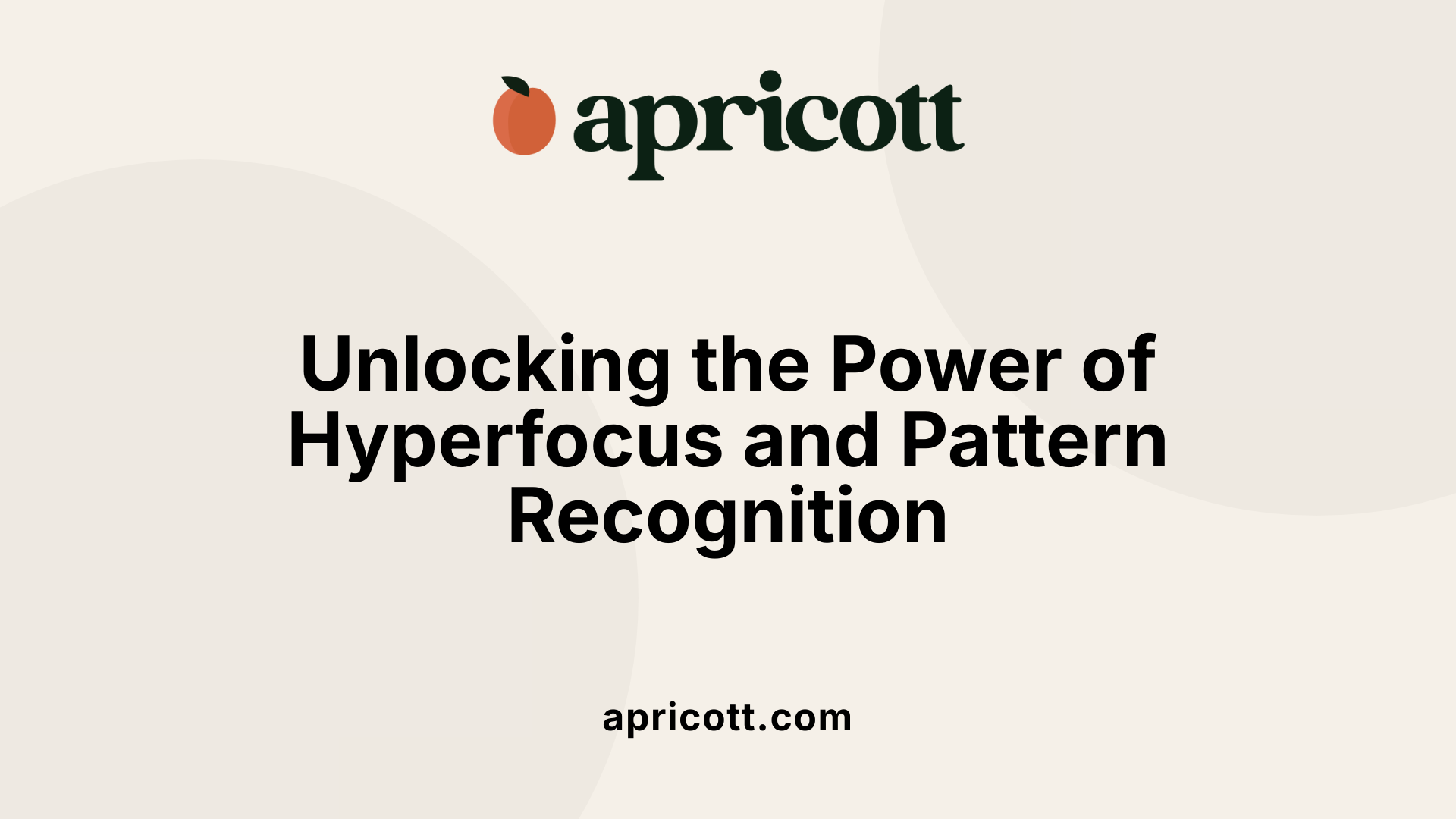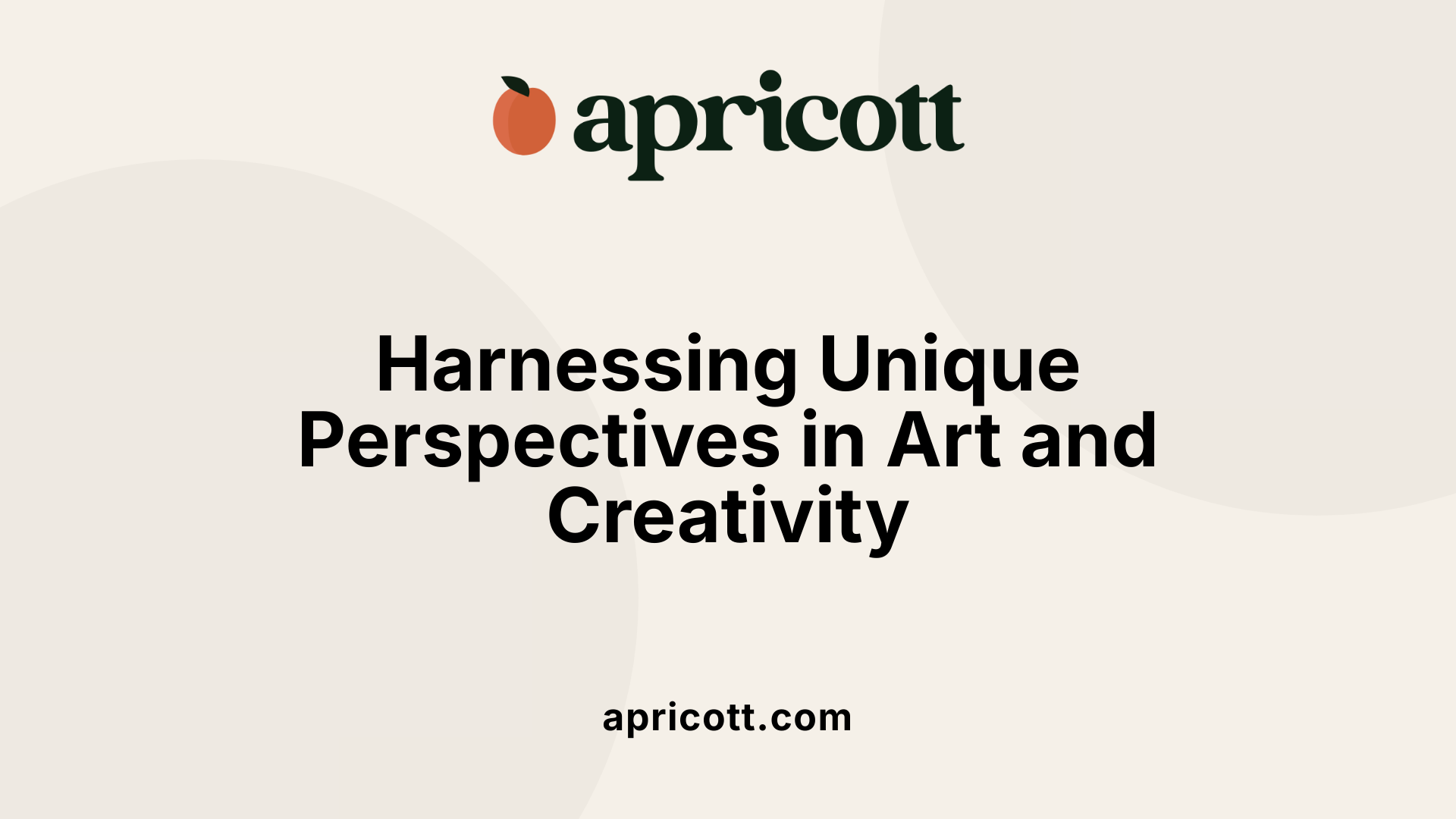August 5, 2025
Embracing Neurodiversity: Uncovering the Unique Strengths of Autistic Individuals
Autism spectrum disorder (ASD) encompasses a wide range of characteristics, traits, and abilities. While often associated with challenges in social communication and sensory sensitivities, a strengths-based perspective reveals the remarkable talents and positive traits that define many autistic individuals. Recognizing these strengths not only promotes greater societal acceptance but also encourages environments where autistic individuals can thrive, contribute, and excel.

Many autistic individuals showcase a wide array of talents and characteristics that can be considered strengths. Notably, they often demonstrate exceptional attention to detail, which helps in tasks requiring precision and thoroughness. Their strong memory enables them to retain vast amounts of information vividly, making them capable of quick learning and recall.
Pattern recognition is another prominent trait, allowing many autistic individuals to identify links and trends that might be unnoticed by others. This skill is especially valuable in fields like mathematics, science, engineering, and the arts, where recognizing structures and sequences can lead to innovative solutions.
Hyperfocus, a state where individuals concentrate intensely on engaging tasks, can lead to high levels of productivity and expertise. People experiencing hyperfocus often develop deep knowledge and skill in their special interests, ranging from astrophysics and vintage clothing to complex scientific concepts.
Creativity and inventiveness are also prevalent. Many autistic people use their unique perspectives as a basis for artistic expression, invention, and problem-solving. These creative abilities foster original ideas and innovative approaches across various domains.
Heightened perceptual abilities—especially in visual and auditory senses—are common. For instance, autistic individuals may have better visual hypersensitivity and pattern recognition, as well as increased auditory pitch detection, making them exceptional listeners and visual thinkers.
Traits like honesty, loyalty, and a strong sense of justice further define the character of many autistic individuals. These qualities foster deep, trusting relationships and a moral drive to advocate for fairness. Their integrity and dedication often inspire trust and admiration.
Understanding and supporting these strengths, along with tailored accommodations, can enable autistic individuals to thrive and contribute their exceptional skills to society. Recognizing these positive attributes emphasizes that autism encompasses a spectrum of powerful abilities that can enrich various aspects of life.
Autistic individuals often possess remarkable abilities that can be viewed as 'superpowers.' Visual thinking is one such strength; many can process and manipulate visual information effortlessly, making them excellent at design, art, and spatial reasoning.
Rapid learning and excellent memory retention enable many autistic people to master complex subjects quickly. Hyperlexia, the ability to read at a very early age, is another example, providing a foundation for accelerated academic growth.
In fields like science, technology, engineering, and mathematics (STEM), strengths such as logical reasoning, attention to detail, and a drive for order contribute to outstanding performance. These skills are complemented by their ability to think systematically and explore unusual, innovative ideas.
Additionally, autistic individuals often experience a profound sense of curiosity and a unique perspective that allows for original thinking. This worldview can be a 'superpower' in creative problem-solving, generating solutions outside traditional frames.
These exceptional abilities highlight the remarkable potential within the autistic community, emphasizing strengths that can be nurtured for personal and societal benefit.
Appreciating the unique strengths of autistic people is essential for promoting true inclusion and embracing neurodiversity. Recognizing skills such as advanced pattern recognition, systematic thinking, and heightened perceptual senses encourages organizations to develop inclusive practices.
Employers and educational institutions can create environments that leverage these strengths by offering tailored accommodations and recognizing diverse cognitive styles. For example, providing quiet workspaces benefits sensory-sensitive individuals, and focusing on performance-based evaluations rather than traditional social norms fosters an equitable environment.
Valuing these abilities can lead to diverse and innovative workplaces, as different perspectives spark creative solutions and enhance productivity. Neurodiversity initiatives that emphasize strengths reduce stigma, build confidence, and improve overall well-being.
This approach cultivates a culture that appreciates unique talents, strengthens community bonds, and unlocks the full potential of autistic individuals, enriching society at large.
In educational and professional contexts, autistic individuals often excel thanks to traits like superior attention to detail, systematic thinking, and impressive memory skills. They can develop deep expertise in their areas of interest, which often leads to high-quality output.
Many autistic people thrive in careers that value pattern recognition, logical reasoning, and creative problem-solving. They may excel in arts, mathematics, engineering, or IT fields.
Their honesty, reliability, and strong sense of moral principles foster trust and stability within teams. Traits like punctuality, dedication, and adherence to routines contribute to consistent and efficiently executed work.
When workplaces and educational settings support and accommodate sensory sensitivities and learning styles, autistic individuals can achieve their full potential—bringing precision, innovation, and fresh insights to their roles.
Autism-related qualities such as heightened visual thinking, attention to detail, hyperfocus, and strong memory help many autistic individuals excel as artists, musicians, and creators. These traits facilitate the production of intricate, original, and technically skilled artworks.
Their unique perspectives and sensory sensitivities enable exploration of diverse artistic mediums, resulting in innovative styles and expressions. For some, art becomes a profound form of emotional expression, social connection, and self-discovery.
Creative pursuits also serve as a source of happiness and confidence. Tailored art and music programs that understand and nurture these strengths can foster emotional well-being and social engagement.
Overall, the artistic talents of autistic individuals are not just a form of expression but a testament to their resilience, creativity, and potential to inspire society with their distinctive visions.

Many autistic individuals possess a range of strengths that greatly benefit their personal and professional lives. One prominent trait is exceptional attention to detail, which allows them to notice nuances and intricacies that others might overlook. Coupled with this is an excellent memory; autistic individuals often retain facts and information vividly, making them highly knowledgeable in their fields of interest.
Moreover, pattern recognition skills are particularly strong, enabling innovative approaches in math, science, engineering, arts, and technology. These traits support high performance and creativity, especially when paired with hyperfocus — an intense concentration on specific interests or tasks.
Creativity and inventiveness are common, often manifesting in artistic talents and inventive problem-solving abilities. Heightened perceptual abilities, especially in visual and auditory domains, add another layer of strength. Visual hypersensitivity and extraordinary vision, along with increased auditory capacity, allow for detailed perception and analysis.
Traits such as honesty, loyalty, and a strong sense of justice foster trustworthy relationships and drive advocacy. Recognizing these strengths, along with implementing personalized support, allows autistic individuals to thrive and make meaningful contributions.
Autistic individuals often possess abilities that can be viewed as superpowers. Visual thinking and pattern recognition stand out, with many being able to see and analyze complex visual information more clearly than neurotypical peers. This enhances skills in art, design, and scientific visualization.
Early reading skills, known as hyperlexia, occur in many autistic children, enabling rapid acquisition of language. Additionally, a remarkable memory enables them to retain and recall detailed information and facts, which can be advantageous in academia and research.
Logical reasoning and technical skills contribute to success in STEM fields—science, technology, engineering, and mathematics. Many autistic people show a drive for order and perfection, excelling in tasks requiring precision. Their ability to focus intensely on their interests often results in deep expertise and innovative insights.
Furthermore, some exhibit a sense of wonder and curiosity, viewing the world uniquely. These qualities, combined with alternative problem-solving skills, can lead to groundbreaking ideas and solutions that benefit society.
Recognizing and valuing the strengths of autistic people play a vital role in fostering inclusive environments. Their unique talents in visual thinking, pattern recognition, creativity, and detailed-oriented problem solving are assets in many settings.
In workplaces, awareness of these strengths encourages employers to adapt hiring practices and workplace accommodations that enable autistic employees to excel. Supporting neurodiverse individuals through tailored work environments and recognition of their talents can lead to increased innovation, productivity, and overall organizational success.
Acceptance and understanding reduce stigma and promote empathy. Creating environments where autistic individuals are valued for their abilities not only benefits them but enriches the entire community by bringing diverse perspectives and ideas. Encouraging a culture of neurodiversity emphasizes that differences in cognition should be celebrated as sources of strength and innovation.
| Strengths of Autistic Individuals | Examples | Impact |
|---|---|---|
| Attention to detail | Precision in work, noticing subtle details | Improved accuracy and quality |
| Pattern recognition | Seeing connections others miss | Innovation and problem-solving |
| Memory skills | Recall of facts and experiences | Knowledge accumulation and expertise |
| Creative thinking | Artistic talents, inventiveness | Unique solutions and artistic contributions |
| Hyperfocus | Deep engagement in interests | High productivity and mastery |
| Logical reasoning | Analytical thinking | Technical achievements |
| Honesty and loyalty | Trustworthiness | Strong relationships and advocacy |
| Visual thinking | Enhanced visualization skills | Advancement in arts and sciences |
| Sensory perception | Increased sensitivity in visual/auditory domains | Improved analysis and creativity |
By embracing these qualities, societies and organizations can build more inclusive and innovative environments that leverage the full potential of neurodiverse individuals.

Autistic individuals often possess exceptional creative abilities, many of which are rooted in their distinctive neurological traits. Traits such as enhanced visual thinking, sharp attention to detail, hyperfocus, and robust memory significantly influence their artistic and creative endeavors.
Enhanced visual thinking allows autistic creators to imagine complex images and concepts vividly. This strength is particularly evident in visual arts, where detailed, original, and technically intricate works are common. Their ability to notice minute details can lead to highly precise and refined artwork, whether in painting, sculpture, or design.
Hyperfocus is another trait that enables autistic artists to immerse themselves deeply in projects, often leading to mastery and innovative exploration within their chosen mediums. This intense concentration can produce work of extraordinary depth and quality, pushing the boundaries of traditional art forms.
Strong memory skills facilitate the retention of intricate patterns, techniques, and ideas, which can be applied practically in composing music, designing mathematical models, or creating mechanical prototypes. These abilities support both technical mastery and originality.
Sensory perception also influences artistic expression. Many autistic individuals experience heightened or unique sensory sensitivities, which can inspire innovative uses of materials and techniques. These sensory insights contribute to the development of novel artistic styles and performances.
Creative interventions that leverage these traits can significantly boost emotional expression and social engagement for autistic individuals. Art therapy, music, and theater are often used to help them communicate feelings and connect with others, fostering self-confidence and emotional well-being.
Moreover, these talents often extend beyond traditional art forms. Many autistic individuals excel in music, mathematics, and mechanical domains, blending artistic sensibility with technical skill.
Overall, autism-related traits provide a rich foundation for creative pursuits. They not only contribute to artistic achievement but also support personal growth, emotional health, and cultural enrichment. By embracing these strengths, society can foster more inclusive and innovative artistic communities.
| Trait | Description | Impact on Creativity |
|---|---|---|
| Visual Thinking | Strong imagery and spatial reasoning | Inspires imaginative visuals and complex designs |
| Attention to Detail | Focused perception of minute features | Produces precise and high-quality work |
| Hyperfocus | Deep concentration on interests | Facilitates mastery and innovative experimentation |
| Memory Skills | Vivid recall of facts, patterns, and techniques | Enhances learning, originality, and technical skills |
| Sensory Perception | Heightened awareness or experience of sensory stimuli | Inspires novel artistic techniques and interpretations |
| Area | Examples | Benefits |
|---|---|---|
| Visual Arts | Painting, sculpture, digital art | Unique styles, detailed works, original perspectives |
| Music | Composition, performance, sound design | Enhanced sensitivity to pitch, rhythm, and timbre |
| Mathematics & Engineering | Problem solving, mechanical design | Innovative solutions, technical precision |
| Cultural Contributions | Exhibitions, performances, community projects | Increased diversity, richer cultural tapestry |
Emphasizing support and recognition of these strengths can help autistic individuals achieve their full potential. Tailored educational programs, workplace accommodations, and inclusive art spaces are vital. Such environments nurture confidence and enable contributions that enrich our collective cultural fabric.
Research worldwide continues to highlight these significant capabilities. Studies confirm that traits like visual thinking, detailed focus, and exceptional memory are not only common but also overwhelmingly advantageous for artistic and scientific pursuits. Recognizing and celebrating these qualities through a strengths-based perspective fosters greater acceptance and societal appreciation for autistic talents.
This approach underscores the value of neurodiversity, emphasizing that the unique ways brains operate can lead to extraordinary creative and intellectual achievements. society benefits when it perceives autism as a source of rich innovation, instead of merely a set of challenges.
In conclusion, the artistic talents and creative strengths of autistic people are profound and diverse. They contribute multiplicatively to cultural, scientific, and technological fields. Supporting these talents through understanding, encouragement, and inclusive opportunities maximizes their positive impact on the world.
Recognizing and nurturing the strengths and abilities of autistic individuals enriches our understanding of human potential. Emphasizing a strengths-based perspective fosters inclusion, innovation, and societal progress. By valuing neurodiversity and supporting individuals’ unique talents, we create a more equitable and vibrant community where everyone can thrive and contribute meaningfully.